Maharashtra Board HSC 12th Exam 2024 : Biology Most Important Question Answers
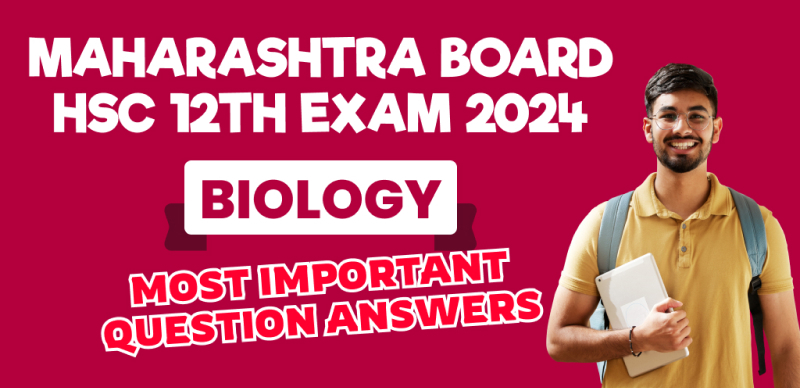
SHARING IS CARING
If our Website helped you a little, then kindly spread our voice using Social Networks. Spread our word to your readers, friends, teachers, students & all those close ones who deserve to know what you know now.
Maharashtra Class 12 exams have started and you have very little time left for the Biology exam. Therefore, we are providing Most Important Answer Type Questions in this article. You can study them well and score well in your exams.
So this article is to help you ace those Most Important MCQs and Short & Long Question Answers with quick and effective last-minute revision.
MCQs (Multiple Choice Questions) are an important part of your Biology exam to score good marks. Mastering them can boost your confidence and lead to important scores. These questions cover various topics from the Biology syllabus. Remember, it is important to understand the logic behind each answer to score well.
Maharashtra Board Biology Most Important Question Answers
Multiple Choice Questions
1. Identify the entomophilous plant from the following:
(a) Bombax
(b) Begonia
(c) Salvia
(d) Callistemon
Ans. (c) Salvia
2. Which of the following condition is not favourable for autogamy in flowers ?
(a) Bisexuality
(b) Homogamy
(c) Cleistogamy
(d) Herkogamy
Ans. (d) Herkogamy
3. Which of the following is a hormone releasing contraceptive ?
(a) Cu-T
(b) Cu-7
(c) Multiload-375
(d) LNG-20
Ans. (d) LNG-20
4. Which of the following group shows ZZ-ZW type of sex determination ?
(a) Pigeon, Parrot, Sparrow
(b) Parrot, Bat, Fowl
(c) Bat, Fowl, Crow
(d) Sparrow, Fowl, Cat
Ans. (a) Pigeon, Parrot, Sparrow
5. The sequence of nitrogenous bases on DNA molecule is ATCGA. Which of the following is the correct complementary sequence of nitrogenous bases on mRNA molecule ?
(a) TAGCT
(b) TAGCA
(c) UAGCU
(d) UACGU
Ans. (c) UAGCU
6. Which of the following are new world monkeys ?
(a) Squirrel monkey, Spider monkey
(b) Orangutan, Baboons
(c) Squirrel monkey, Baboons
(d) Gibbons, Baboons
Ans. (a) Squirrel monkey, Spider monkey
7. Which of the following characteristic is not shown by the ape ?
(a) Prognathous face
(b) Tail is present
(c) Chin is absent
(d) Forelimbs are longer than hind limbs
Ans. (b) Tail is present
8. What is rhizosphere ?
(a) Root ball formed by growth of roots
(b) Covering of root tip
(c) Microenvironment around root
(d) Region of root hairs
Ans. (c) Microenvironment around root
9. Which hormone is known as stress hormone ?
(a) Auxin
(b) Gibberellin
(c) Ethylene
(d) Abscissic acid
Ans. (d) Abscissic acid
10. Pacemaker of heart is .............. .
(a) SA node
(b) AV node
(c) His bundle
(d) Purkinje fibres
Ans. (a) SA node
11. Which one of the following pairs correctly matches a hormone with a disease resulting from its deficiency ?
(a) Parathyroid hormone - Diabetes insipidus
(b) Luteinising hormone - Diabetes mellitus
(c) Insulin - Hyperglycaemia
(d) Thyroxine - Tetany
Ans. (c) Insulin - Hyperglycaemia
12. Which of the following diseases can be contracted by droplet infection ?
(a) Malaria
(b) Chicken pox
(c) Pneumonia
(d) Rabies
Ans. (c) Pneumonia
13. Where is antigen D present ?
(a) On Rhesus factor
(b) On the surface of RBCs
(c) On A antigen
(d) On AB antigen
Ans. (b) On the surface of RBCs
14. Which hormone is used in MOET method ?
(a) GH
(b) LH
(c) FSH
(d) ICSH
Ans. (c) FSH
15. First biopatent was procured for genetically engineered bacterium
(a) Pseudomonas
(b) Agrobacterium
(c) Azatobacter
(d) E-coli
Ans. (a) Pseudomonas
16. Select the statement which explains best parasitism.
(a) One species is benefited.
(b) Both the species are benefited.
(c) One species is benefited, other is not affected.
(d) One species is benefited, other is harmed.
Ans. (d) One species is benefited, other is harmed.
17. What is celebrated on 5th June every year ?
(a) World ozone day
(b) Earth day
(c) World environment day
(d) Biodiversity day
Ans. (c) World environment day
18. Which is the most important service provided by environment ?
(a) Release of oxygen
(b) Formation of ozone layer
(c) Carbon assimilation in photosynthesis
(d) Agents of pollination
Ans. (c) Carbon assimilation in photosynthesis
19. Which is the most well-known pattern of biodiversity ?
(a) Species-Area relationship
(b) Latitudinal gradient
(c) Longitudinal gradient
(d) Altitudinal gradient
Ans. (b) Latitudinal gradient
20. Name the scientist who studied ecosystem by using analogy of "The Rivet Poppet Hypothesis'.
(a) John Muir
(b) Alexander von Humboldt
(c) Robert May
(d) Paul Ehrlich
Ans. (d) Paul Ehrlich
Very Short Answer Questions
(1) What is budding in plants ?
Ans. Budding in plants is an artificial method of propagation in which a single bud is joined or grafted on the stock plant.
(2) At which stage pollen grains are shed from anther in Angiosperms ?
Ans. In bicelled stage pollen grains are shed from anther in Angiosperms.
(3) Which glands contribute fluids to the semen ?
Ans. The glands which contribute fluids to the semen are seminal vesicles, prostate gland. Cowper's glands add mucus to semen.
(4) Where does fertilization and implantation occur ?
Ans. Fertilization of ovum takes place in the ampulla region of fallopian tube, whereas implantation occur in the endometrium of uterus.
(5) What are polygenes ?
Ans. When a character is controlled by two or more than two pairs of genes, the genes are called polygenes.
(6) What is degeneracy of genetic code ?
Ans. Genetic code has degeneracy as 61 codons code for 20 amino acids, that is two or more codons can specify the same amino acid. E.g. Cysteine has two codons, while isoleucine has three codons.
(7) What is the scientific name of modern man ?
Ans. Homo sapiens is the scientific name of modern man.
(8) What is isotonic condition in osmotic system ?
Ans. A condition where concentration of solution has neither gain nor loss of water in an osmotic system is called isotonic condition.
(9) Why is ABA called a stress hormone ?
Ans. ABA induces dormancy in seeds by inhibiting growth. Thus plants can tide over adverse environmental conditions. Hence it is called as stress hormone.
(10) What is nitrogen assimilation ?
Ans. Nitrogen present in the soil as nitrates, nitrites and ammonia is absorbed by plants and converted into nitrogenous organic compounds is nitrogen assimilation.
(11) What is the difference between tachycardia and bradycardia ?
Ans. The faster heart rate over 100 beats per minute is called tachycardia, while the slower heart rate below 60 beats per minute is called bradycardia.
(12) In which part thyroid gland stores its hormones ?
Ans. The lumen of thyroid follicles store the thyroid hormones in the form of thyroglobulins.
(13) Which are the diseases that can be avoided by eradication of mosquitoes ?
Ans. Malaria, dengue, chikungunya and filariasis or elephantiasis can be avoided by eradication of mosquitoes.
(14) What is duration of biopatent ?
Ans. Duration of biopatent is five years from the date of the grant or seven years from the date of filling the patent application whichever is less.
(15) Which Act was passed to protect and improve the quality of environment ?
Ans. In order to protect and improve the quality of our environment, the Government of India has passed the Environment Protection Act, 1986.
(16) What are sticky ends ?
Ans. Sticky ends are short extensions of cleaved DNA molecule which can form hydrogen bonded base pairs with other complementary sticky ends.
(17) What is algal bloom ?
Ans. Algal bloom is excessive growth of planktonic freely floating blue-green algae caused due to presence of large amount of nutrients in water.
(18) Which habitats do not show latitudinal and altitudinal gradients ?
Ans. Arid and semiarid habitats and aquatic habitat do not show latitudinal and altitudinal gradients.
(19) What is the relationship between species richness and latitudinal gradient ?
Ans. Species richness is high at lower latitudes and there is a steady decline towards the poles, i.e. species richness for plants and animals decreases as we move away from equator to the poles.
(20) Who coined the term biodiversity ?
Ans. The term biodiversity was coined by Walter Rosen in 1982.
Short Answer Questions
(1) Define polyembryony. State its different types.
Ans.
1. Polyembryony : Development of more than one embryo, inside the seed is called polyembryony.
2. Polyembryony can be true or false. In true polyembryony many embryos arise in the same embryo sac. In false polyembryony they are in different embryo sacs in the same ovule.
3. Adventive polyembryony : In this embryo develops directly from the diploid cell of nucellus and integuments, e.g. citrus.
4. Cleavage polyembryony : In this zygote proembryo divides into many parts or units, each of which develops into an embryo.
(2) What is pollination ? What are its two types ?
Ans.
1. Pollination : The transfer of pollen grains from the anther to the stigma is called pollination.
2. Types of pollination : Pollination is of two types, viz., self-pollination and cross pollination.
(i) Self-pollination (Autogamy) : The transfer of pollen grains from the anther to the stigma of the same flower or a different flower possessing the same genetic make-up is called self-pollination.
(ii) Cross pollination (Allogamy) : The transfer of pollen grains from the anther of a flower to the stigma of another flower borne by a different plant possessing dissimilar genetic make-up is called cross pollination.
(3) A woman is unable to conceive due to blockage in her upper segment of oviduct. State the infertility treatment to be given to her and describe it.
Ans.
1. A woman having blockage in her upper segment of oviduct, will have to undergo 'GIFT' treatment.
2. When the oocyte is collected from donor and transferred into the fallopian tube of another female, the technique is called GIFT. This female provides suitable environment for further development.
3. When the entrance or upper segments of the fallopian tubes are blocked, this technique is used.
4. Oocytes and sperms are directly injected into regions of the fallopian tubes. Here fertilization takes place forming a blastocyst. It later enters the uterus for implantation.
(4) Explain the chromosomal theory of inheritance.
Ans. Chromosomal theory of inheritance was put forth by Sutton and Boveri after studying parallel behaviour of genes and chromosomes during meiotic division. This theory states following points :
1. Chromosomal theory identifies chromosomes as the carrier of genetic material.
2. All the hereditary characters are transmitted by gametes. Nucleus of gametes, i.e. sperms and ova of the parents contain chromosomes which transmit the heredity to offspring.
3. Chromosomes are found in pairs in somatic or diploid cells.
4. During gamete formation, homologous chromosomes pair and segregate independently at meiosis. The diploid condition is converted into haploid condition. Thus each gamete contains only one chromosome of a pair.
5. During fertilization, the union of sperm and egg restores the diploid number of chromosomes.
(5) Write the aims of human genome project.
Ans.
1. To sequence 3 billion base pairs of DNA in human genome and to map an estimated 33000 genes.
2. To store the information collected from the project in databases.
3. To develop tools and techniques for analysis of the data.
4. Transfer of the related technologies to the private sectors, such as industries.
(6) State the major changes that took place in the evolution of man.
Ans. Major evolutionary changes seen in man :
1. Increase in size and complexity of brain and enhanced intelligence with increased cranial capacity.
2. Bipedal locomotion with erect posture.
3. Opposable thumb.
4. Shortening of forelimbs and lengthening of hind limbs.
5. Development of chin and orthognathous face.
6. Broadening of pelvic girdle, development of lumbar curvature.
7. Articulated speech, art, development of tools, social and cultural development.
(7) Explain the limitations of root pressure theory.
Ans. Limitation of root pressure theory :
1. Not applicable to tall plants above 20 metres.
2. Even in absence of root pressure ascent of sap is noticed.
3. In actively transpiring plants, root pressure is not developed.
4. In taller gymnosperms, root pressure is zero.
5. Xylem sap is under tension and shows negative hydrostatic pressure.
(8) Give any four physiological effects and application of ethylene.
Ans.
1. Ethylene is a gaseous growth inhibitor hormone.
2. It promotes ripening of fruits like bananas, apples and mangoes. The commercial application of ethephon is done.
3. It initiates growth of lateral roots.
4. Dormancy of buds and seeds is broken by its application.
5. It accelerates formation of abscission layer and thus abscission of leaves, flowers and fruits is observed.
6. Ethylene is responsible for checking growth of lateral buds thus causes apical dominance and retards flowering.
7. Process of senescence of plant organs is enhanced.
8. Epinasty, i.e. drooping of leaves and flowers results due to its application in some plants.
(9) A person met with a small accident and bleeds, but very soon stops bleeding. Explain the physiological process responsible for this.
Ans.
1. The bleeding stops due to blood clotting. It is extrinsic process as the tissue is damaged.
2. There are twelve clotting factors (I to XII). They interact in a cascade manner leading to formation of enzyme, Thromboplastin.
3. Thromboplastin helps in the formation of prothrombinase.
4. Prothrombinase inactivates heparin and converts prothrombin into thrombin.
5. Thrombin converts fibrinogen into fibrin. Fibrin is insoluble and forms mesh in which the blood cells are entangled forming a clot.
(10) Why is pancreas called a dual gland ?
Ans.
1. Pancreas is called a dual gland because it is exocrine as well as endocrine in nature.
2. The exocrine pancreas secretes digestive enzymes through acini.
3. The endocrine pancreas secretes hormones through its endocrine cells called Islets of Langerhans.
(11) What are the modes of transmission of HIV or AIDS ?
Ans. The transmission of HIV occurs through following routes :
1. Sexual relations, mainly unsafe sexual contact: including oral, vaginal and anal sex.
2. Through blood and blood products either by blood transfusions or sharing needles and syringes.
3. Transplacental: From pregnant mother to her foetus through placenta. Nursing mother can also transmit HIV to her baby through lactation.
4. Spreading the virus is very rare in case of accidental needle injury, artificial insemination with infected donated semen and transplantation with infected organs.
5. HIV is seen in urine, tears, saliva, breast milk and vaginal secretions but unless these body fluids enter the injuries and wounds, transmission is not easy.
(12) What are the effects of biotechnology with relation to human health ?
Ans. Following are the effects of biotechnology on human health :
1. Allergies : Unexpected allergic reactions are seen due to GMO crops.
2. Long-term effects : Long-term effects of GMO technology is not yet fully understood as this technology is relatively recent.
3. New Proteins : Proteins which were never ingested before by humans are now being consumed due to biotechnology. This may have bad effect on human health.
4. Food additives : Antibiotic and vaccine-resistant strains of pathogens may be produced by adding additives to food. This may create bioethical problems.
(13) What is the maximum number of trophic levels in a food chain ?
Ans.
1. There are maximum four trophic levels in an ecosystem.
2. Rarely five levels are seen where it is occupied by apex consumer.
3. But as the trophic levels are moving from producers to consumers, lesser and lesser energy remains.
4. Through heat loss, lot of amount of energy is dissipated, therefore no ecosystem can sustain fifth trophic level.
(14) Tropical regions exhibit species richness as compared to polar regions. Justify.
Ans.
1. Tropical regions are bestowed by thicker vegetation and ample food due to available sunlight and humidity.
2. Polar regions are covered over with snow, with almost no vegetation.
3. Only handful species of animals can survive here due to their adaptations.
4. Species richness always shows latitudinal gradient for many plants and animal species. It is high at lower latitudes and there is a steady decline towards the poles. Therefore, tropical regions show more species richness.
(15) Explain Productivity Stability Hypothesis.
Ans.
1. Productivity Stability Hypothesis emphasises the importance of species diversity to the ecosystem. This hypothesis was given by David Tillman.
2. It states that rich diversity leads to lesser variation in biomass production over a period of time and species richness is not needed for maintaining the stability of an ecological community.
3. If average biomass production remains fairly constant over a period of time, then that community remains stable.
4. The stable community remains strong to withstand disturbances and also recover quickly. Such community is resistant to invasive species.
(16) What are the two types of nucleases ? What is their function ?
Ans.
1. The two types of nucleases are exonucleases and endonucleases.
2. Exonucleases remove nucleotides from the ends of the DNA.
3. Endonucleases are those enzymes that have ability to make cuts at specific positions within the DNA molecule.
4. of the endonucleases, restriction endonucleases serve as the molecular scissors in genetic engineering experiments.
5. They are used for cutting DNA molecules at specific predetermined sites. This is needed for gene cloning or recombinant DNA technology.
(17) Explain different types of restriction enzymes.
Ans. Different types of restriction enzymes are as follows :
1. Type I They function simultaneously as endonuclease and methylase e.g. Ecok.
2. Type II They exhibit separate cleaving and methylation activities. They are more stable and are used in r-DNA technology e.g. EcoRI, BglI. They cut DNA at specific sites within the palindrome. Thousands of type II restriction enzymes have been discovered.
3. Type III - They cut DNA at specific non-palindromic sequences e.g. Hpal, Mboll.
(18) What are the effects of parasite on the host ?
Ans.
1. Most of the parasites cause harm to the host.
2. Host is affected by reducing its survival, growth and reproduction.
3. Some parasites can also be fatal to the host causing death of the host.
4. The population density of host species is reduced by parasites.
5. The host species become more vulnerable to predation by making it physically weak.
(19) With suitable examples describe commensalism.
Ans.
1. Commensalism : Commensalism is the interaction between two species in which one species derives benefit and the other one is neither harmed nor benefited.
2. Examples of commensalism :
(i) Orchid grows as epiphyte on other big trees. The tree does not get any benefit but is neither harmed. But orchid gets support.
(ii) Cattle egret is the insectivorous bird which forage close to cattle. When cattle move, the hidden insects in the grass are flushed out. These insects are then captured by egrets. Cattle do not get benefit but birds do.
(iii) Sea anemone has stinging cells on the tentacles which offer protection to clown fish. Clown fish gets the protection from other predators, whereas, sea anemone does not derive any benefit from this association.
(20) What are the symptoms of pneumonia ?
Ans.
1. Main symptoms of infectious pneumonia are cough producing greenish or yellow sputum or phlegm and a high fever with chills.
2. Shortness of breath, stabbing chest pain, coughing up blood, headaches, sweaty and clammy skin, loss of appetite, fatigue, blueness of the skin, nausea, vomiting, mood swings and joint pains or muscle aches are some other symptoms.
(21) What are different types of cross pollination based on the biotic pollinating agents ?
Ans. Cross pollination through biotic agents are entomophily, ornithophily and chiropterophily.
1. Entomophily : Pollination effected through insects is called entomophily. Insect pollinated plants are called entomophilous. Entomophily is seen in plants like Hibiscus, Rose, Salvia, Cestrum, Jasmine, etc.
2. Ornithophily : Pollination effected through the agency of birds is called ornithophily. Bird pollinated plants are called ornithophilous plants. Ornithophily is seen in plants like Callistemon, Bombax, Butea, etc.
3. Chiropterophily : Pollination effected through bats is called chiropterophily. Bat pollinated plants are called chiropterophilous plants. Chiropterophily is seen in plants like Anthocephalous (Kadamb tree), Adansonia (Baobab tree), Kigellia (Sausage tree).
(22) Give the name of causal organism of Syphilis and write on its symptoms.
Ans.
1. Syphilis is a sexually transmitted venereal disease caused by a Spirochaete bacterium Treponema pallidum.
2. The site of infection is the mucous membrane in genital, rectal and oral region.
3. Symptoms of syphilis :
(i) Primary lesion known as chancre at the site of infection.
(ii) They are seen on the external genitalia in males and inside the vagina in females.
(iii) Skin rashes accompanied by fever, inflammed joints and loss of hair.
(iv) Paralysis.
(v) Degenerative changes in the heart and brain.
(23) Explain the chromosomal theory of inheritance.
Ans. Chromosomal theory of inheritance was put forth by Sutton and Boveri after studying parallel behaviour of genes and chromosomes during meiotic division. This theory states following points :
1. Chromosomal theory identifies chromosomes as the carrier of genetic material.
2. All the hereditary characters are transmitted by gametes. Nucleus of gametes, i.e. sperms and ova of the parents contain chromosomes which transmit the heredity to offspring.
3. Chromosomes are found in pairs in somatic or diploid cells.
4. During gamete formation, homologous chromosomes pair and segregate independently at meiosis. The diploid condition is converted into haploid condition. Thus, each gamete contains only one chromosome of a pair.
5. During fertilization, the union of sperm and egg restores the diploid number of chromosomes.
(24) Explain the role of lactose in 'Lac Operon'.
Ans.
1. A small amount of beta-galactoside permease enzyme is present in cell even when Lac operon is switched off and it allows a few molecules of lactose to enter into the cell.
2. Lactose binds to repressor and inactivates it.
3. Repressor - lactose complex cannot bind with the operator gene, which is then turned on.
4. RNA polymerase transcribes all the structural genes to produce lac m-RNA which is then translated to produce all enzymes.
5. Thus, lactose acts as an inducer.
6. When the inducer level falls, the operator is blocked again by repressor and structural genes are repressed again. This is negative feedback.
(25) What are the application of genomics ?
Ans. Applications of genomics are as follows :
1. Structural and functional genomics is used in the improvement of crop plant, human health and livestock.
2. The knowledge and understanding acquired by genomics research can be applied in medicine, biotechnology and social sciences.
3. It helps in the treatment of genetic disorders through gene therapy.
4. It helps in the development of transgenic crops having desirable characters.
5. Genetic markers have applications in forensic analysis.
6. Genomics can lead to introduction of new gene in microbes to produce enzymes, therapeutic proteins and biofuels.
(26) (a) What is connecting link ?
(b) Which fossil animal is considered as the connecting link between reptiles and birds ? Give any one character of each class found in it.
Ans.
(a) Connecting link : A connecting link is an intermediate or transitional state between two systematic groups of organisms. It bears characters common to both these groups on either side of its position. Thus it represents an evolutionary line.
(b) 1. Connecting link between reptiles and birds is Archaeopteryx.
2. Reptilian characters :
(i) Jaws with homodont (all similar) teeth. Bones are nonpneumatic i.e. solid.
(ii) Ribs have a single head. Sternum without keel.
3. Avian characters :
(i) Forearms modified into wings.
(ii) Feathery exoskeleton.
(27) Describe physiological effect and applications of gaseous hormone in plants.
Ans. Physiological effect of gaseous hormones in plants :
1. Ethylene is a gaseous growth inhibitor hormone.
2. It promotes ripening of fruits like bananas, apples and mangoes. The commercial application of ethephon which is ethylene, is done.
3. It initiates growth of lateral roots.
4. Dormancy of buds and seeds is broken by its application.
5. It accelerates formation of abscission layer and thus abscission of leaves, flowers and fruits is observed.
6. Ethylene is responsible for checking growth of lateral buds thus causes apical dominance and retards flowering.
7. Process of senescence of plant organs is enhanced.
8. Epinasty, i.e. drooping of leaves and flowers results due to its application in some plants.
9. It increases activity of chlorophyllase enzyme causing degreening effect in banana and Citrus fruits.
(28) Name the stress hormone in plants. Describe its physiological effects.
Ans. Name of the stress hormone : Abscissic acid Physiological effects of abscissic acid (ABA) in plants :
1. Abscissic acid influences abscission and dormancy.
2. ABA accelerates senescence of leaves, flowers and fruits.
3. It is a stress hormone as it is produced during drought and other unfavourable climatic conditions.
4. ABA induces dormancy in seeds, buds and tubers.
5. It acts as growth inhibitor as it retards growth.
6. ABA plays an important role in closing of stomata to check transpiration.
7. It inhibits and delays cell division and suppresses cambial activity by inhibiting mitosis in vascular cambium.
8. ABA inhibits flowering in LDP and stimulates flowering in short day plants (SDP).
(29) Describe steps in breathing.
Ans. Inspiration and expiration together make breathing.
(a) Inspiration :
1. Inspiration is an active process brought about by ribs, intercostal muscles, sternum and diaphragm.
2. The intercostal muscles contract and pull the ribs outwards. This increases the space in the thoracic cavity. The lower part of sternum is simultaneously raised. The diaphragm contracts and flattens. This causes further increase in the volume of thoracic cavity.
3. Pressure in the lungs decreases and the volume increases due to expansion of the lungs.
4. Due to pressure difference the atmospheric air rushes into the lungs through respiratory passage as a result of which air is inspired in.
(b) Expiration :
1. Expiration is the passive process.
2. During expiration the intercostal muscles relax and the ribs are pulled inwards.
3. The diaphragm is relaxed and becomes dome-shaped.
4. The volume of the thoracic cavity is reduced.
5. The pressure on the lungs is increased as a result of which they get compressed.
6. Air is thus expelled out of lungs through the nares.
(30) Explain properties of nerve fibres.
Ans. Properties of nerve fibres :
1. Excitability or irritability : The nerve fibres have the capacity to perceive stimulus and then enter the state of activity. This property is due to polarised membrane.
2. Conductivity : Nerve fibres can transmit the excitation.
3. Stimulus : Stimulus can be detected by nerve fibres.
4. Summation effect : Nerve fibres have the property to sum up many weak stimuli which are subliminal and then produce an impulse.
5. All or none law : The nerves either conduct an impulse along its length and or will not conduct at all.
6. Refractory period : The time interval about millisecond during which a nerve fails to respond is refractory period. Nerves have such refractory period.
7. Velocity : The rate of transmission of impulse is higher in land and thick nerves.
Long Answer Questions
1. (a) Give the term to describe the entry of pollen tube into the ovule through the following parts : (i) Micropyle, (ii) Chalaza, (iii) Integument
(b) State any five significances of double fertilization.
Ans.
(a) Terms to describe entry of pollen tube into the ovule :
(i) Through micropyle: Porogamy
(ii) Through chalaza : Chalazogamy
(iii) Through integument: Mesogamy
(b) Significance of double fertilization :
(i) Double fertilization is unique feature in Angiosperms in which seed with food store is produced.
(ii) Diploid zygote is produced through double fertilization which later forms new plant.
(iii) Triploid PEN forms nutritive endosperm tissue.
(iv) Diploid condition of the plant is restored by fusion of haploid male and female gametes through syngamy.
(v) Double fertilization avoid polyembryony.
2. Describe outbreeding devices which encourage cross pollination.
Ans.
1. Unisexuality, dichogamy, prepotency, self sterility, heteromorphy and herkogamy are the outbreeding devices.
2. Unisexuality : The plants bear either male or female flowers. Due to unisexual nature, self-pollination is avoided. Plants are either dioecious, e.g. Papaya or monoecious, e.g. maize.
3. Heteromorphy : In same plants different types of flowers are produced. In these flowers, stigmas and anthers are situated at different levels. There is heterostyly and heteroanthy. This prevents self-pollination e.g. Primrose.
4. Herkogamy : In bisexual flowers we may come across mechanical device to prevent self-pollination. Natural physical barrier avoids contact of pollens with stigma. e.g. Calotropis where pollinia are situated below the stigma.
5. Prepotency : In prepotency pollens of other flower germinate rapidly rather than from the same flower. E.g. Apples.
6. Self sterility or Self incompatibility: It is a genetic mechanism in which pollen germination is inhibited on the stigma of the same flower. E.g. Tobacco, Thea.
3. (a) Which type of strains of bacteria were used by Griffith in his experiment ?
(b) Explain the four types of experiments performed by him.
(c) What conclusions were derived from these experiments ?
Ans.
(a) 1. In 1928, Frederick Griffith, carried out experiments with bacterium Streptococcus pneumoniae (which causes pneumonia in humans and other mammals).
2. Griffith used two strains of Streptococcus pneumoniae :
(i) S-type (Virulent, smooth, pathogenic and encapsulated).
(ii) R-type (Non-virulent, rough, non-pathogenic and non-capsulated).
(b) Experiments carried out by F. Griffith :
(i) Mice were injected with R-strain bacteria and they survived (no pneumonia).
(ii) Mice injected with S-strain bacteria developed pneumonia and died.
(iii) When heat-killed S-strain bacteria were injected in mice, the mice survived.
(iv) On injecting a mixture of heat-killed S-bacteria and live R-bacteria, the mice died.
(c) Griffith concluded that the live R-strain bacteria must have picked up something (which he called transforming principle) from the heat killed S bacterium, and got changed into S-type. Transforming principle allowed R-type to synthesize capsule and it became virulent.
4. Describe the process of transcription in protein synthesis.
Ans. Transcription involves three stages, viz. Initiation, Elongation and Termination.
(1) Initiation :
(a) RNA polymerase binds to promoter site.
(b) It then moves along the DNA and causes local unwinding of DNA duplex into two strands in the region of the gene.
(c) Only antisense strand functions as template.
(2) Elongation :
(a) The complementary ribonucleoside tri-phosphates get attached to exposed bases of DNA template chain.
(b) As transcription proceeds, the hybrid DNA-RNA molecule dissociates and makes m-RNA molecule free.
(c) As the m-RNA grows, the transcribed region of DNA molecule becomes spirally coiled and regains double helical form.
(3) Termination : When RNA polymerase reaches the terminator site on the DNA, both enzyme and newly formed m-RNA (primary transcript) gets released.
5. Describe Lac 'Operon'.
Ans. Lac operon consists of the following components:
1. Regulator gene :
(a) Regulator gene precedes the promoter gene.
(b) It may not be present immediately adjacent to operator gene.
(c) Regulator gene codes for a repressor protein which binds with operator gene and represses (stops) its action.
2. Promoter gene :
(a) It precedes the operator gene.
(b) It is present adjacent to operator gene.
(c) RNA Polymerase enzyme binds at promoter site. Promoter gene base sequence determines which strand of DNA acts a template.
3. Operator gene :
(a) It precedes the structural genes.
(b) When operator gene is turned on by an inducer, the structural genes get transcribed to form m-RNA.
4. Structural gene :
(a) There are 3 structural genes in the sequence lac-Z, lac-Y and lac-A.
(b) Enzymes produced are B-galactosidase, B-galactoside permease and transacetylase respectively.
(c) Inducer : Allolactose acts as an inducer. It inactivates the repressor by binding with it.
6. (a) Enlist the four steps of translation in protein synthesis.
(b) What is start codon ?
(c) What are stop codons ?
Ans. (a) 1. Activation of amino acids and formation of t-RNA-amino acid complex.
2. Initiation of polypeptide chain.
3. Elongation of polypeptide chain.
4. Termination and release of polypeptide.
(b) Start codon is AUG of mRNA, when anticodon UAC is there.
(c) Stop condons are UAA, UAG and UGA.
7. (a) What are the five factors as per the modern synthetic theory of evolution ?
(b) What is gene flow and genetic drift ?
Ans. (a) (1) Gene mutations, (2) Chromosomal mutations, (3) Genetic recombinations, (4) Natural selection, (5) Reproductive isolation.
(b) 1. Gene flow : Movement of genes into or out of a population. Migration of organism, or gametes (dispersal of pollens) or segments of DNA (transformation).
2. Genetic drift : Any random fluctuation (alteration) in allele frequency, occurring in the natural population by pure chance. Smaller populations may show genetic drift.
8. Write an account of auxins as growth regulators.
Ans.
1. Auxins are plant growth regulators produced naturally by plants.
2. They are weak organic acids capable of promoting cell elongation during the growth of stem and root.
3. Auxins are synthesized in shoot and root apices besides young leaf primordia.
4. Auxins may be natural or synthetic.
5. Naturally occurring auxins are indole-3-acetic acid (IAA) and its derivatives.
6. NAA, 2, 4-D and 2,4, 5-T are synthetic auxins.
7. Auxins in higher concentration promote the growth of stem.
8. Auxins play an important role in initiation and promotion of cell division.
9. Auxins help in the formation of adventitious roots from cuttings when applied in lower concentration.
10. Auxins play an important role in apical dominance.
11. Auxin prevents abscission by preventing the action of hydrolytic enzymes in abscission layer.
12. Auxins are used to produce parthenocarpic fruits in plants like orange, apple, tomato and grapes.
9. Explain in brief the factors affecting blood pressure.
Ans.
1. Cardiac output : Normal cardiac output is 5 lit/min. Increase in cardiac output increases systolic pressure.
2. Peripheral resistance : Peripheral resistance depends upon the diameter of blood vessels. Decrease in diameter of arterioles and capillaries under the effect of vasopressin cause increase in peripheral resistance and thereby increase in blood pressure.
3. Blood volume : Loss of blood in accidents decreases blood volume and thus cause decrease in blood pressure.
4. Viscosity of blood : Blood pressure is directly proportional to viscosity of blood.
5. Age : Blood pressure increases with age due to increase in inelasticity of blood vessels.
6. Venous return : Amount of blood brought to the heart via the veins per unit time is called the venous return and it is directly proportional to blood pressure.
7. Length and diameter of blood vessels : Blood pressure is directly proportional to the total length of the blood vessels. Blood pressure can also be affected by vasoconstriction or vasodilation.
8. Gender : Females have slightly lower BP than males of her age before menopause. However, the risk of high BP increases in the females after menopause sets in.
10. What are the different ways of treating cancer ?
Ans. Cancer treatment consists of combination of a number of therapies which are follows :
1. Chemotherapy : Chemotherapy means giving certain anticancer drugs. These drugs check cell division by inhibiting DNA synthesis. Some normal cells are also killed by chemotherapy causing side effects such as hair loss or anaemia.
2. Radiotherapy : The cancer cells are bombarded with the radiations from radioactive materials such as cobalt, iridium and iodine. The X-rays, gamma rays and charge particles are used to destroy the cancerous tissue or cells. They cause minimum damage to the surrounding normal tissue or cells.
3. Surgery : Entire cancerous tissue or cells are removed surgically. E.g. breast tumour or uterine tumour. After removing the cancerous tissue, additionally other treatments are also given.
4. Immunotherapy : For tackling with tumour, patients are given biological response modifiers such as x-interferon which activates their immune system to destroy the tumour.
5. Supportive therapy : With supportive therapy, patient's quality of life is increased. To treat symptoms of cancer and side effects of cancer treatments, this therapy is used. This therapy varies depending upon condition of individual patient.
11. Explain concept of outbreeding and its types.
Ans.
1. Outbreeding involves breeding of two unrelated animals.
2. It is of three types, viz. outcrossing, cross-breeding and interspecific hybridization.
3. Outcrossing :
(a) Outcrossing involves mating of animals of same breed, which do not have a common ancestors on either side of mating partners up to 4 to 6 generations.
(b) The progeny obtained from such mating is called an outcross.
(c) Outcrossing is done to overcome inbreeding depression.
4. Crossbreeding :
(a) In crossbreeding superior males of one breed are mated with superior females of another breed.
(b) New animal breeds of desirable characters are developed by this method.
(c) Example : Hisardale breed of sheep is developed in Punjab by crossing Bikaneri ewes and Marino rams.
5. Interspecific hybridization :
(a) It involves breeding of animals of two different but related species.
(b) It is used to produce animals with desirable characters from both the parents.
(c) e.g. Mule is a breed obtained from horse and donkey.
(d) It may not be always successful.
12. (a) What is polymerase chain reaction (PCR) ?
(b) Describe any steps involved in mechanism of PCR.
Ans. (a) Polymerase chain reaction (PCR) : PCR or polymerase chain reaction is the technique used for gene amplification or gene multiplication in vitro by which billions copies of desired segments as of DNA or RNA can be made rapidly.
(b) Steps involved in mechanism of PCR :
1. Denaturation : The reaction mixture is heated at 90-98 °C. Due to this hydrogen bonds in the DNA break and two strands of DNA separate. This is called denaturation.
2. Annealing of primer: When the reaction mixture is cooled to 40-60 °C, the primer pairs with its complementary sequences in ssDNA. This is called annealing.
3. Extension of primer: In this step, the temperature is increased to 70-75 °C. At this temperature thermostable Taq DNA polymerase adds nucleotides to 3'end of primer using single-stranded DNA as template. This is called primer extension. Duration of this step is about two minutes.
13. What are the different ways in which organisms adapt to the changes in the environment ?
Ans. To survive and propagate further in any environment, organisms show one of the four possible ways, viz. regulate, conform, migrate and suspend.
1. Regulate : In this method, organisms maintain homeostasis by physiological and behavioural changes. Due to homeostatic regulation, they can perform thermoregulation or osmoregulation. E.g. All birds and mammals show constant body temperature and osmotic concentration irrespective of external temperature.
2. Conform : Most of the animals and plants are unable to maintain a constant internal environment. Their body parameters change according to outside environment. E.g. Poikilothermic animals cannot maintain body temperature but they are simple conformers. In few aquatic animals, the osmotic concentration of the body fluids changes according to surrounding osmotic concentration. Few conformers can regulate the parameters in limited range.
3. Migrate : When organism is unable to cope up with surrounding temperatures, they migrate temporarily from such stressful habitat to a more favourable habitat. After the stressfulle period is over, they return back. Birds show long-distance migrations
during severe winter.
4. Suspend : Suspending the life activities for particular period is one of the methods to cope up with stressful conditions. Seeds of plants remain dormant over unfavourable period and once favourable conditions are resumed they start growing. This state is called dormancy during which metabolic activities are suspended. Hibernation and aestivation seen in some animals is also for escaping severe winter or summer respectively. E.g. Polar bear shows hibernation while snails and fish show aestivation. These are also suspension measures.
14. Explain the 'Competitive Exclusion Principle' given by Gause.
Ans. Gause's 'Competitive Exclusion Principle' :
1. This principle states that two closely related species competing for the same resources cannot co-exist indefinitely and the competitively inferior one will be eliminated eventually.
2. The Gause's principle may be true if resources are limiting, but not otherwise. More recent studies do not support such gross generalisations about competition. The species during competition also show resource partitioning.
3. In resource partitioning, the species facing competition might evolve mechanisms that promote co-existence rather than exclusion. If two species compete for the same resource, they could avoid competition by choosing, for instance, different times for feeding or different foraging patterns. E.g. Five closely related species of warblers living on the same tree were able to avoid competition and co-exist due to behavioural differences in their foraging activities. If there are two competing species and one is comparatively superior than the other, then the inferior one remains restricted to smaller geographical area. If this superior species is removed then only the inferior species expands its range.
15. Define decomposition and describe the processes and products of decomposition.
Ans.
1. Decomposition is the process carried out by the decomposer organisms.
2. Most of the bacteria, actinomycetes and fungi are decomposers. They convert the dead and decaying organic matter into simpler compounds. These simpler inorganic substances return back to the environment.
3. Decomposition takes place through detritus food chain. It starts from the dead organic matter. Detritus eating organisms called detritivores like earthworm, etc. breakdown the detritus into smaller fragments. Therefore, this first step of decomposition is called fragmentation.
4. Water soluble inorganic nutrients seep into the soil after fragmentation. These nutrients get precipitated as salts. Therefore, this second step of decomposition is called leaching,
5. The third step of decomposition is called catabolism. In this step, fungal and bacterial enzymes degrade the detritus into simple inorganic substances.
6. The partially decomposed organic matter is called humus which is formed by the process of humification. Humus is a dark coloured amorphous substance which is the reservoir of nutrients.
7. Humus too undergoes decomposition by bacterial action at a very slow rate and ultimately releases inorganic matter. This process is therefore called mineralization.
8. Decomposition requires oxygen in greater amount. The rate of decomposition is dependent upon the temperature and the humidity of the environment.
16. Species richness goes on decreasing as we move from equator to pole. Explain.
Ans.
1. In tropical regions, there are lesser climatic changes throughout the year and availability of plenty of sunlight.
2. Moreover, in tropical areas there are lesser disturbances like periodic glaciations as compared to those seen in the polar regions.
3. In tropical regions, there is a stability over millions of years which favoured speciation and hence there is more species richness.
4. Also in tropical regions, there are lesser migrations which reduce gene flow between geographically isolated regions. This too favoured speciation.
5. There is more availability of intense sunlight, warmer temperatures and higher annual rainfall in tropics. These factors have brought higher species richness in tropics.
6. Constant climatic conditions and abundance of resources in tropical regions provide more food preferences for animal species. E.g. Fruits are available throughout the year in rain forests, therefore, variety of frugivorous animals are seen here, as compared to the temperate regions.
In short, species richness or diversity for plants and animals decreases as we move away from equator to the poles.
17. Explain the following terms with reference to ecological succession.
1. Seral stages.
Ans. The developmental stages of the ecological succession are known as seral stages.
2. Pioneers.
Ans. The organisms belonging to first seral stage in the ecological succession are known as pioneers.
3. Hydrosere.
Ans. Hydrosere or hydrarch succession is a type of ecological succession which is determined by the amount of water available during succession. Hydrosere occurs when there is abundant water available in the area where organisms reside.
4. Xerosere.
Ans. Xerosere or xerarch succession is a type of ecological succession which is determined by the amount of water available during succession. Xerosere occurs when there is very little water available in the area where organisms reside. Such succession is observed in desert regions.
18. What are the different types of ecosystem services ? Describe briefly.
Ans. Ecosystem services are of following four categories :
1. Supporting services : Support to the life on earth such as nutrient cycling, primary production, soil formation, habitat provision, pollination and overall maintenance of balance of ecosystem.
2. Provisioning services: Provides necessities such as food in the form of crops, fruits and seafood, raw materials such as timber, skins, fuel wood, genetic resources in the form of seeds, crop improvement genes, and health care, other resources such as water, medicinal resources in the form of test and assay organisms and ornamental resources such as furs, feathers, ivory, orchids, butterflies, etc.
3. Regulating services: Regulation of processes on the earth such as carbon sequestration, prey-predation regulation, waste decomposition and detoxification, purification of water and air and pest control.
4. Cultural services: Under this category, humans get services from nature in the form of cultural, spiritual and historical, recreational experiences, opportunity to learn science and indulge learn science and indul in education, and pets and animal therapy.
19. Describe the ill-effects of alcoholism on health.
Ans.
1. Alcohol in any form is toxic for the body. Hence as soon as alcohol is consumed, the liver tries to detoxify it.
2. In low doses it acts as a stimulant but in high dose, it acts on central nervous system, especially the cerebrum and cerebellum. Still higher dose can induce a comatose condition.
3. Alcohol affect the gastrointestinal tract by causing inflammation and damage to gastric mucosa. Ulceration and painful condition arises in alcoholics.
4. Excessive doses of alcohol induce vomiting.
5. The worst effect of alcohol is on liver causing diseases like cirrhosis.
6. Alcohol induces hypertension and cardiac problems.
7. Apart from physical effect, it causes deterioration of mental health and emotional well-being.
8. Alcoholic person cannot think due to numbness in his/her cerebrum.
20. Describe different types of immunity.
Ans. There are two basic types of immunity, viz. innate immunity and acquired immunity.
(a) Innate immunity :
1. Innate immunity is natural, inborn immunity, which helps the body to fight against the invasion of microorganisms.
2. Innate immunity is non-specific because it does not depend on previous exposure to foreign substances.
3. Innate immunity mechanisms consist of various types of barriers such as anatomical barriers, physiological barriers, phagocytic barriers and inflammatory barriers. They prevent entry of foreign agents into the body.
(b) Acquired immunity :
1. The immunity that an individual acquires during his life is called acquired immunity or adaptive immunity or specific immunity. It helps the body to adapt by fighting against specific antigens hence it is called adaptive immunity. Since it is produced specifically against an antigen, it is called specific immunity.
2. Acquired immunity takes long time for its activation.
3. This type of immunity is seen only in vertebrates.
4. Due to acquired immunity, the body is able to defend against any invading foreign agent.
Definition
(1) Clones.
Ans. Morphologically and genetically identical individuals are called clones.
(2) Amphimixis.
Ans. It is the process which involves the production of offspring by the formation and fusion of gametes.
(3) Alleles or Allelomorphs.
Ans. The two or more alternative forms of a given gene which are present on the identical loci on the homologous chromosomes are called alleles of each other.
(4) Codon.
Ans. Codon is a triplet of nucleotides present on the m-RNA which specifies one particular amino acid.
(5) Mendelian population.
Ans. Small interbreeding group of a population is defined as Mendelian population.
(6) Active absorption.
Ans. Water absorption by activity of root which is against the D.P.D. gradient along with expenditure of ATP generated at the time of respiration is called active absorption.
(7) Efficiency index.
Ans. The increased growth per unit time is called an efficiency index.
(8) Dead space (DS).
Ans. The volume of air that is present in the respiratory tract (from nose to the terminal bronchioles), but not involved in gaseous exchange is called dead space (150 ml).
(9) Limbic system.
Ans. A complex neuronal circuit formed by the hypothalamus, amygdala, parts of epithalamus and thalamus, hippocampus and other areas is called a limbic system.
(10) Resistance.
Ans. Ability to ward off damage or disease throughout defence mechanism is called resistance.
(11) Outcrossing.
Ans. Breeding of animals of the same breed but having no common ancestors for 4 to 6 generations is known as outcrossing.
(12) Crossbreeding.
Ans. Breeding of superior male of one breed with superior female of another breed is known as crossbreeding.
(13) Vector.
Ans. Vectors are DNA molecules that carry a foreign DNA segment and replicate inside the host cell.
(14) Parasitism.
Ans. The interaction between two species in which one parasitic species derives benefit from the other host species by harming it, is called parasitism.
(15) Biodiversity.
Ans. Biodiversity is part of nature which includes the differences in the genes among the individuals of a species; the variety and richness of all plants and animal species at different scales in a space - local regions, country and the world; and the types of ecosystem, both terrestrial and aquatic, within a defined area.
Match the Columns Questions
1.
|
Column I |
Column II |
| (1) egg | (a) testa |
| (2) nucellus | (b) tegmen |
| (3) outer integument | (c) perisperm |
| (4) inner integument | (d) embryo |
Ans.
(1) egg - (d) embryo
(2) nucellus - (c) perisperm
(3) outer integument - (a) testa
(4) inner integument - (b) tegmen
2.
| Column I [Organs] | Column II [Functions] |
| (1) Epididymis | (a) Transport of sperms |
| (2) Sertoli cells | (b) Copulatory organ |
| (3) Vas deferens | (c) Nourishment to developing sperms |
| (4) Penis | (d) Maturation of sperms |
Ans.
(1) Epididymis - (d) Maturation of sperms
(2) Sertoli cells - (c) Nourishment to developing sperms
(3) Vas deferens - (a) Transport of sperms
(4) Penis - (b) Copulatory organ
3.
| Column I | Column II |
| (1) Connecting link between ape and man | (a) Homo erectus |
| (2) Ape man | (b) Homo habilis |
| (3) Handy man like | (c) Neanderthal man |
| (4) Advanced prehistoric man | (d) Australopithecus |
Ans.
(1) Connecting link between ape and man - (d) Australopithecus
(2) Ape man - (a) Homo erectus
(3) Handy man like - (b) Homo habilis
(4) Advanced prehistoric man - (c) Neanderthal man
4.
| Respiratory surface | Organism |
| (1) Plasma membrane | (a) Insect |
| (2) Lungs | (b) Salamander |
| (3) External gills | (c) Bird |
| (4) Internal gills | (d) Amoeba |
| (5) Trachea | (e) Fish |
Ans.
(1) Plasma membrane - (d) Amoeba
(2) Lungs - (c) Bird
(3) External gills - (b) Salamander
(4) Internal gills - (e) Fish
(5) Trachea - (a) Insect
5.
| Column I |
Column II |
| (1) Nutritive tissue of embryo | (a) Perisperm |
| (2) Remnants of nucellus in seed | (b) Cotyledon |
| (3) Nutritive tissue of developing microspores | (c) Endosperm |
|
(4) First photosynthetic organ of embryo |
(d) Tapetum |
Ans.
(1) Nutritive tissue of embryo - (c) Endosperm
(2) Remnants of nucellus in seed - (a) Perisperm
(3) Nutritive tissue of developing microspores - (d) Tapetum
(4) First photosynthetic organ of embryo - (b) Cotyledon
6.
| Column I | Column II |
| (1) 21 trisomy | (a) Turner's syndrome |
| (2) X-monosomy | (b) Klinefelter's syndrome |
| (3) Holandric traits | (c) Down's syndrome |
| (4) Feminized male | (d) Hypertrichosis |
Ans.
(1) 21 trisomy - (c) Down's syndrome
(2) X-monosomy - (a) Turner's syndrome
(3) Holandric traits - (d) Hypertrichosis
(4) Feminized male - (b) Klinefelter's syndrome
7.
| Column I | Column II |
| (1) Glucagon | (a) Neurohypophysis |
| (2) Adrenaline | (b) Islets of Langerhans |
| (3) Somatotropins | (c) Adenohypophysis |
| (4) ADH | (d) Medulla |
Ans.
(1) Glucagon - (b) Islets of Langerhans
(2) Adrenaline - (d) Medulla
(3) Somatotropins - (c) Adenohypophysis
(4) ADH (a) Neurohypophysis
8.
| Column I | Column II |
| (1) AIDS | (a) Antibody production |
| (2) Lysozyme | (b) Activation of B-cells |
| (3) B-cells | (c) Immunoglobulin |
| (4) T-helper cells | (d) Tears |
| (5) Antibody | (e) Immuno deficiency |
Ans.
(1) AIDS (e) Immuno deficiency
(2) Lysozyme (d) Tears
(3) B-cells - (a) Antibody production
(4) T-helper cells - (b) Activation of B-cells
(5) Antibody (c) Immunoglobulin
9.
| Column I | Column II |
| (1) Metchnikoff | (a) ABO Blood group system |
| (2) Fleming | (b) Concept of immunity |
| (3) Edward Jenner | (c) Phagocytic cells |
| (4) Karl Landsteiner | (d) Lysozyme |
Ans.
(1) Metchnikoff - (c) Phagocytic cells
(2) Fleming - (d) Lysozyme
(3) Edward Jenner - (b) Concept of immunity
(4) Karl Landsteiner - (a) ABO Blood group system
10.
| Column I | Column II |
| (1) Chloromycetin | (a) Streptomyces griseus |
| (2) Erythromycin | (b) Streptomyces aurifaciens |
| (3) Streptomycin | (c) Streptomyces Venezuelae |
| (4) Terramycin | (d) Streptomyces erythreus |
Ans.
(1) Chloromycetin - (c) Streptomyces Venezuelae
(2) Erythromycin - (d) Streptomyces erythreus
(3) Streptomycin - (a) Streptomyces griseus
(4) Terramycin - (b) Streptomyces aurifaciens
11.
| Column I (Biofortified crop) | Column II (Nutrient Enrichment) |
| (1) Maize | (a) Five times more iron |
| (2) Rice | (b) Twice the amount of lysine and tryptophan |
| (3) Wheat Atlas-66 | (c) Enriched in vitamin A and minerals |
| (4) Carrots, spinach | (d) High protein content |
Ans.
(1) Maize - (b) Twice the amount of lysine and tryptophan
(2) Rice - (a) Five times more iron
(3) Wheat Atlas-66 - (d) High protein content
(4) Carrots, spinach - (c) Enriched in vitamin A and minerals
12.
| Column I (Organic Acids) | Column II (Microbial source) |
| (1) Citric acid | (a) Rhizopus arrhizus |
| (2) Fumaric acid | (b) Acetobacter aceti |
| (3) Gluconic acid | (c) Aspergillus niger |
| (4) Acetic acid | (d) Aspergillus niger |
Ans.
(1) Citric acid - (c) Aspergillus niger
(2) Fumaric acid - (a) Rhizopus arrhizus
(3) Gluconic acid - (d) Aspergillus niger
(4) Acetic acid - (b) Acetobacter aceti
13.
| Column I (Types of interaction) | Column II (Examples) |
| (1) Mutualism | (a) Plasmodium vivax |
| (2) Ectoparasite | (b) Lichen |
| (3) Endoparasite | (c) Orchid |
| (4) Commensalism | (d) Ticks on dogs |
Ans.
(1) Mutualism - (b) Lichen
(2) Ectoparasite - (d) Ticks on dogs
(3) Endoparasite - (a) Plasmodium vivax
(4) Commensalism - (c) Orchid
14.
| Column I | Column II |
| (1) Pioneer species | (a) Entire gradient of communities |
| (2) Climax species | (b) Spatial pattern |
| (3) Succession | (c) Quercus |
| (4) Sere | (d) Crustose lichen |
Ans.
(1) Pioneer species - (d) Crustose lichen
(2) Climax species - (c) Quercus
(3) Succession - (b) Spatial pattern
(4) Sere - (a) Entire gradient of communities
15.
| Column I | Column II (Examples) |
| (1) Particulate pollutant | (a) Lead, Cadmium |
| (2) Gaseous pollutant | (b) Mercury, DDT |
| (3) Biomagnification | (c) Carbon monoxide, Methane |
| (4) Heavy metals | (d) Dust, Smog |
Ans.
(1) Particulate pollutant - (d) Dust, Smog
(2) Gaseous pollutant - (c) Carbon monoxide, Methane
(3) Biomagnification - (b) Mercury, DDT
(4) Heavy metals - (a) Lead, Cadmium
Diagram Based Questions
1. Name the figure given below. Identify label A and B. Explain its development.
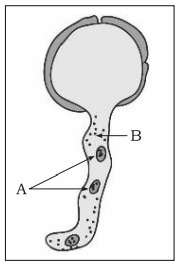
Ans. This is a male gametophyte. A : Male gamete B : Pollen tube.
Development of male gametophyte :
(1) Microspore or pollen grain is first cell of male gametophyte.
(2) The protoplast of pollen grain divides mitotically to form two unequal cells - a small thin walled generative cell and a large naked vegetative or tube cell.
(3) The generative cell possesses thin cytoplasm and a nucleus. It separates and floats in the cytoplasm of vegetative cell.
(4) The vegetative cell, possesses thick cytoplasm. irregular shaped nucleus and the reserved food.
(5) In majority of the angiosperms, the pollen grains are liberated at two-celled stage after the dehiscence of the anther.
(6) The generative cell of the pollen grain divides by mitosis to form two male non-motile gametes.
2. Sketch and label the diagram of ovule most commonly seen in angiosperms.
Ans.
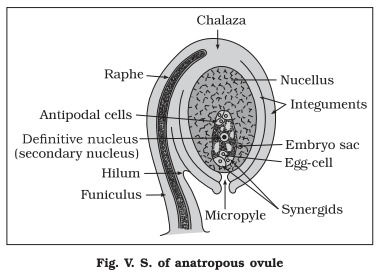
3. Double fertilization.
Ans.
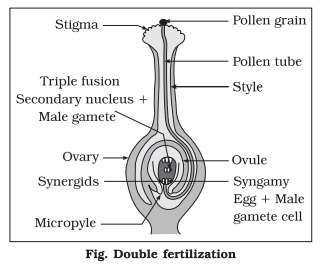
4. Give the name and functions of 'A' and 'B' from the given diagram.
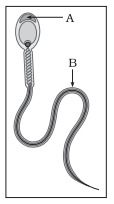
Ans.
(1) 'A' is acrosome.
Function of acrosome : Acrosome produces lytic enzyme, hyaluronidase and thus helps in the penetration of the egg during fertilization.
(2) 'B' is tail of the human sperm.
Function of tail : Tail lashes continuously and helps the movement of the sperm in the female genital tract.
5. (a) Identify A, B and C in the given diagram.
(b) The given diagram represent life cycle of ..................... .
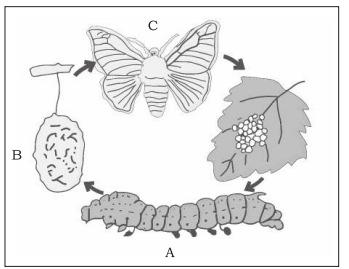
Ans.
(a) A : Mature caterpillar, B : Cocoon and C : Adult female
(b) Silk moth (Bombyx mori)
6. Draw a labelled diagram of biogas plant.
Ans.

7. Draw two crosses to show inheritance of colour blindness.
(i) A cross between colour blind male and normal female.
(ii) A cross between carrier female and normal male.
Ans.
(i) A cross between colour blind male and normal female.
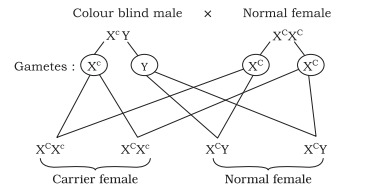
(ii) A cross between carrier female and normal male.
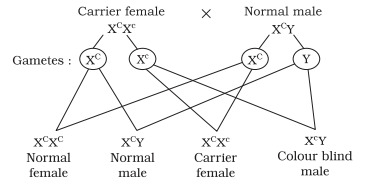
8. Identify A, B, C, D in the given diagram of human reproductive system :
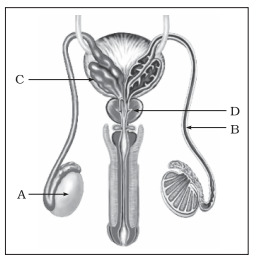
Ans. A : Testis, B : Vas deferens, C : Seminal vesicle, D : Prostate gland.
9. Draw a neat labelled diagram of the conducting system of human heart and label AV node, Bundle of His and Purkinje fibres.
Ans.

10. Observe the given diagram and answer the questions given below :
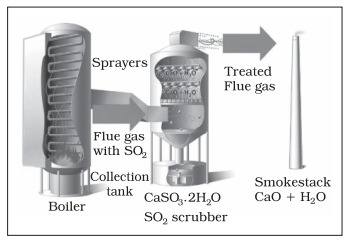
(a) What is the name of this equipment ?
(b) What is the function of such equipment ?
(c) Explain its working in brief.
Ans.
(a) Exhaust gas scrubber.
(b) Exhaust gas scrubbers are used to clean air by removing both dust and gases.
(c) The exhaust is passed through dry or wet packing material. When it is done, gases like SO2 are removed. For this purpose, the exhaust is passed through a spray of water or lime.







 Profile
Profile Signout
Signout












 Quiz
Quiz
 Get latest Exam Updates
Get latest Exam Updates 










